Shovels don’t strike as a complicated tool, and it isn’t; however, it is more complex than many may think. Most people need to realize all shovels are different and serve the same purpose; this is why they often get the wrong type when looking for a shovel for their project.
A shovel is a hand tool for digging the ground and packing and moving materials to different positions, among other things. This tool features a blade typically made from steel or reinforced plastic and medium-length handles made from wood, and steel, among other materials. Getting the right Shovel for your digging needs requires a general understanding of the different types of shovels available.
Most people need to learn that Shovels have specific uses and, as such, use a particular shovel for any digging task and wonder why they get poor results. You only have to buy a specific type of Shovel if you use them more often. You can rent the Shovel you need from your local equipment rental store. Here we’ll be talking about the different types of shovels you will need for every digging situation.
Types of Shovels For Digging Needs
Shovels help in digging, among other things, with each digging situation requiring a specific type of Shovel. This section will look at the different shovels and when to use them for your digging needs.
| IMAGE | PRODUCT | FEATURES | PRICE |
|---|---|---|---|
| Edging Shovel | • Extra-large D-handle • 4.81 ounces • 46 inches | ||
| Round Digging Shovel | • Perfect for gardening • Comfortable non-slip grip • Lightweight fiberglass | ||
| Pointed Digging Shovel | • 8-inch round point blade • Great for digging holes • Easy lifting | ||
| Square Digging Shovel | • Lightweight • Soft non-slip grip • Comfortable | ||
| Trench Shovel | • Comfortable • Soft non-slip grip • Drain spades heads | ||
| Drain Shovel | • Durable Handle • Sharp Blades • Premium Lawn & Garden Product | ||
| Post Hole Shovel | • Strong Blade • Durable tempered steel blade • Strength and durability | ||
| Handheld Shovel | • Polished aluminum head • Easy to hold • Sturdiness | ||
| Snow Shovel | • Impact-resistant blade • D-Ring handle grips • Shovel blade with aluminum wear strip | ||
| Flat Shovel | • Tempered Steelhead • Lightweight Fiberglass Handle • Comfortable | ||
| Folding Shovel | • Sturdy & Durable • Perfect for Gift • Portable & Compact | ||
| Root Shovel | • Garden digging shovel • Sturdy • Durable | ||
| Tree Planting Shovel | • Welded 14-gauge steel blade • Extra-large D-handle design • Light weight | ||
| Clam Shovels | • Lightweight • Extra-large D-handle design • Ideal for digging small |
1. Edging Shovel
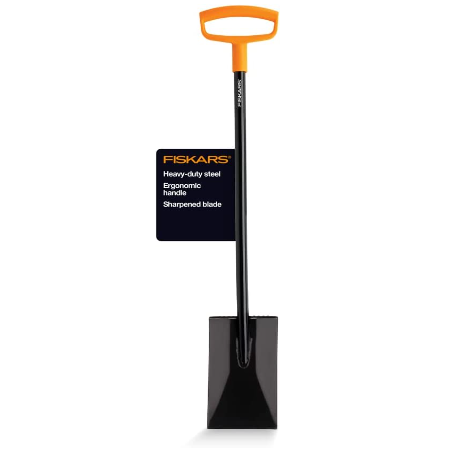
Edging shovels are perfect for creating edges at the end of your lawn. It provides accuracy when edging due to the style of the blade with the tip flat. In addition, you can use the edging Shovel to move soil along fences, sidewalks, and more. Typically edging shovels have short blades because they do not have to be cut deep. They are reserved for activities like distributing garden soil to other parts of the yard and breaking up plant roots.
The most common shape of the edging Shovel is a short blade with a half-moon tip, while others have a slightly longer blade and a straight tip. However, they both have flat tips to make precise cuts into the soil along the edges.
2. Digging Shovel
Digging shovels have assumed the role of the Shovel in general, as most people think about them when considering shovels. Digging shovels break up the soil for gardening or during simple DIY construction. Since digging shovels typically see a lot of pressure on the grip to high the ground, the grip collar is tall. It may either be on the shaft or have a specialized handle. The blades of digging shovels vary in size, with round, pointed, and square among the most popular shovel blades available.
Round Digging Shovel
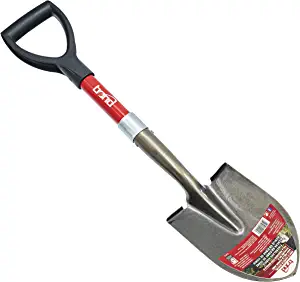
This digging shovel sports a blade with a rounded tip, great for digging loose soil in the garden and moving shallow root plants. The round tip and slight curve of the blade make it possible to move these plants from the root without damaging other plants around it.
Pointed Digging Shovel
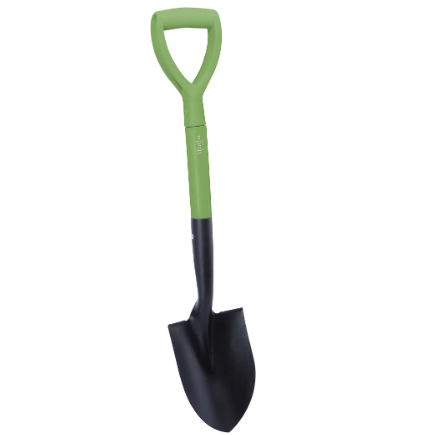
This is another shovel great for digging loose soil, similar to the round shovel. However, the pointed Shovel has a thinner blade with a pointed top that makes it possible to work in tight spaces where there are other plants or rocks.
Square Digging Shovel
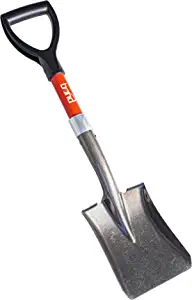
The blades in this digging Shovel have a flat square tip that makes it possible to dig up the soil, almost like an edging shovel. While the other two shovel blades may only be suited to digging loosened soil, square digging shovels can handle the hardened ground.
3. Trench Shovel
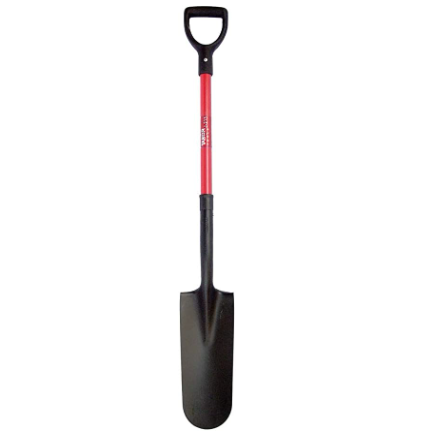
A trench or ditch shovel makes shallow trenches and can clean up channels of all sizes, including deeper ditches. The long and narrow blade of the trench shovel is set at an angle, so making or cleaning gutters is possible. The edge sports a thinner tip to make it easier to break into the soil, while either side of the blade is slightly raised to enable soil packing.
The length and style of a trench shovel blade make it challenging to use your weight to apply pressure to the Shovel, which is ideal when seeking to concern energy. Instead, you’ll need arm power to exert the required energy to make ditches which is why deeper gutters are difficult.
4. Drain Shovel
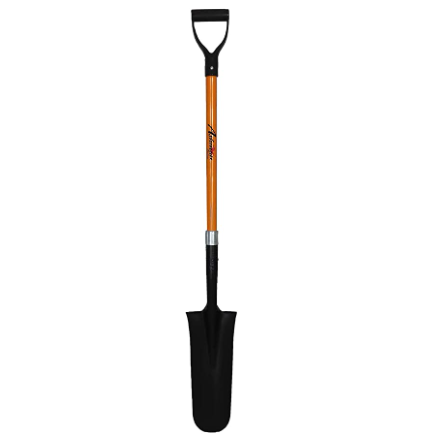
The drain shovel is similar to the trench shovel in shape, with its elongated and narrow blade presenting characteristics. However, the drain shovel blade features a round tip rather than the straight tip found in ditch shovels. The drain shovel landscaping tool is perfect for shaping the ground and making holes for transplanting or posts for your mailboxes.
5. Post Hole Shovel
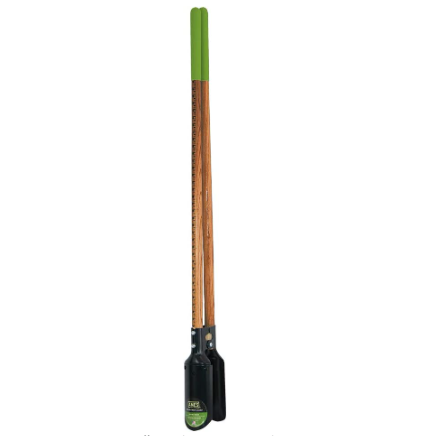
The post-hole Shovel is slightly different from anything you’ll see here, with its double blade and shaft giving it a unique look for a popular activity. Digging post holes can be challenging without the proper tool, with this post hole shovel posing as an excellent tool to make holes for posts as it can break through hard soil with lots of shallow roots.
The blades are long, narrow, and curved inwards towards each other, while their tips are round. Pulling the handles to close the edges will form a cylindrical shape that creates post holes by digging, pinching, and lifting the soil from the ground. Holes created using the post hole shovel are neater and take considerably less effort, and time to make, so this Shovel is ideal if you have to make a lot of post holes.
Also Read: 5 Best Air Hammer Reviews: Our Top 5 Picks
6. Handheld Shovel
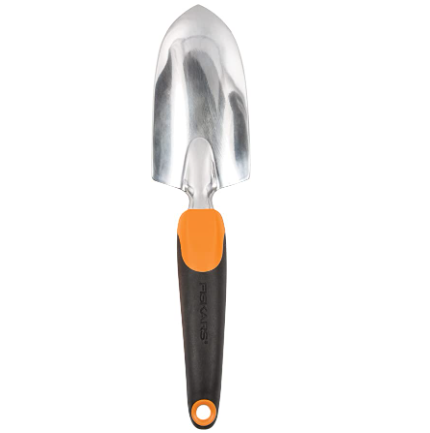
The Shovel is called a handheld, garden shovel, or hand shovel because of its size. It feels like a miniature shovel, typically used with one hand and for small garden activities like making shallow holes for plants and digging up plants and weeds. A shovel is an essential tool if you have a garden, as it allows you to do minor digging without having to deal with large shovels.
The blade of this Shovel is narrow and usually about 4 inches long with rounded or pointed tips. In comparison, the shaft is about 6 inches long. With a blade slightly curved inwards, it makes it easier to pack soil or plant roots.
7. Snow Shovel
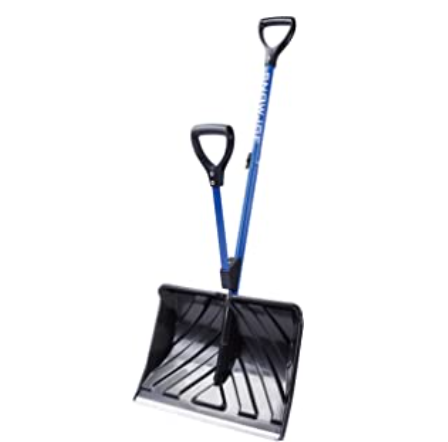
Living in areas with a lot of snow presents the unique challenge of clearing the snow when it builds up. The snow shovel is the ideal Shovel to dig out and clear snow. Snow shovels are also called scoop shovels because they scoop the snow with their wide blades. The blade is wide and slightly curved, making it possible to move a lot of snow quickly.
Aside from moving snow, you can use this Shovel to clear debris, dirt, and even gravel from an area. However, it is not built to withstand much pressure on its grip and shaft area since snow packing hardly requires much pressure.
8. Flat Shovel
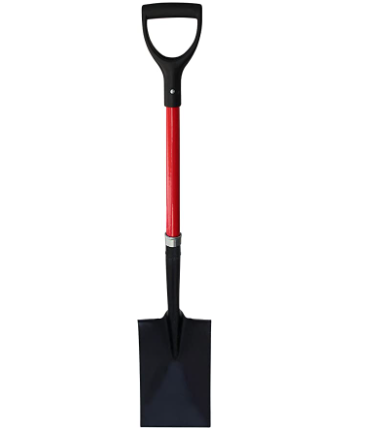
The blade of this Shovel is flat, with a typical straight tip and a slightly concave design. Shovels with these blades are ideal for scooping and moving soil and other materials like rock and mulch. With a level blade tip, you’ll get decent digging; however, the blade is large, which will help you move more materials at once and easily apply added pressure.
You’ll find this Shovel helpful when moving and spreading soil, digging loose dirt, and clearing trenches. Flat shovels are popular and can be found in most gardens for moving materials around.
9. Folding Shovel
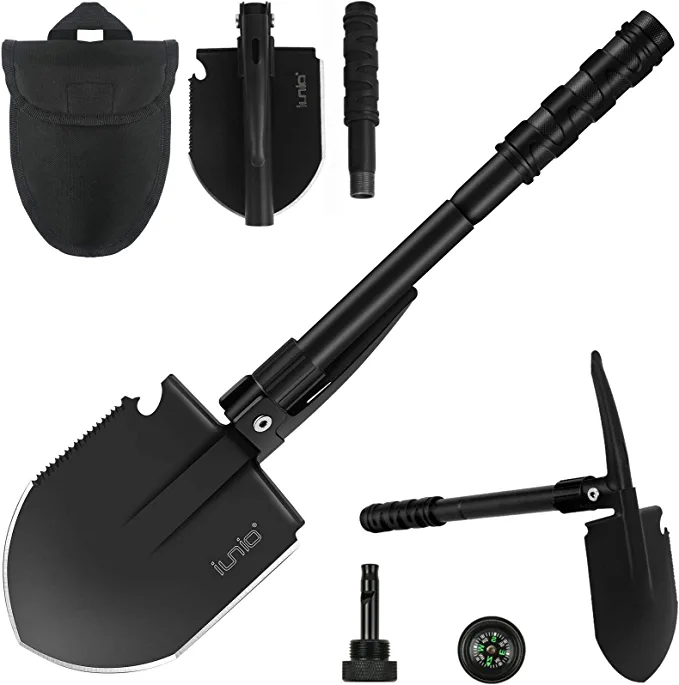
Folding shovels are often portable shovels with foldable designs. Their portability is the most significant pull to getting the shovels. You can either collapse or bend the shaft to get a smaller shovel you can quickly move or store. The issue of durability will always arise when discussing folding shovels. However, you should get regular-level durability as standard shovels as long as the foldable Shovel comes with a steel handle.
Most folding shovels are not ideal for heavy-duty digging due to their size and movable parts. However, their advantage is in the size as you can have them in your car, in your camping bag, among other activities.
10. Root Shovel
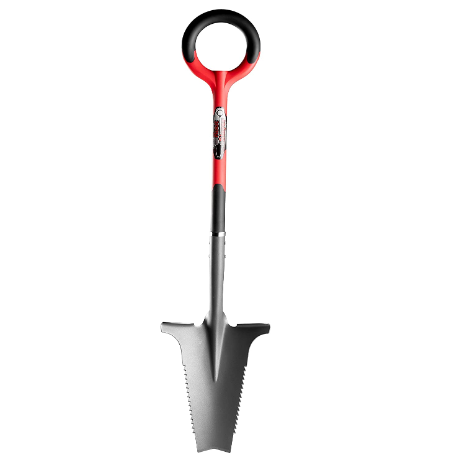
A root shovel, as the name implies, is a shovel that cuts through the root of other plants in the soil. You can grow another plant in a conducive environment without it having to struggle for scarce resources with the more established roots. The blades of root shovels are typically elongated and triangular with a curved top so you can press the edge into the ground by stepping on it. Its spiked blade sides cut the root as it goes into the ground.
Aside from cutting roots so other plants can thrive, this root shovel is also ideal for removal. The shape and style of the root shovel make it easy to penetrate the ground and cut through tough roots in the soil.
Read More: 27 Different Types of Pliers and Their Uses
11. Tree Planting Shovel
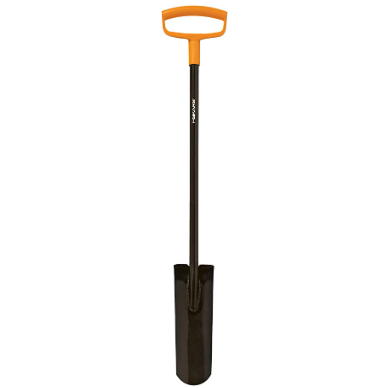
Planting trees requires a shovel that can dig a hole in a narrow space and is tough enough to cut through hardened soil and shallow roots that may be in the ground. Here is a tree planting shovel specifically for planting trees.
It sports a long, narrow blade that makes digging deep into the ground easier to create the holes to plant tree saplings. Tree planting shovels with long shafts will dig deeper holes on flat and even grounds and are ideal for bigger tree saplings. The shovels with shorter shafts are best suited for digging hills or sloped areas.
12. Clam Shovels
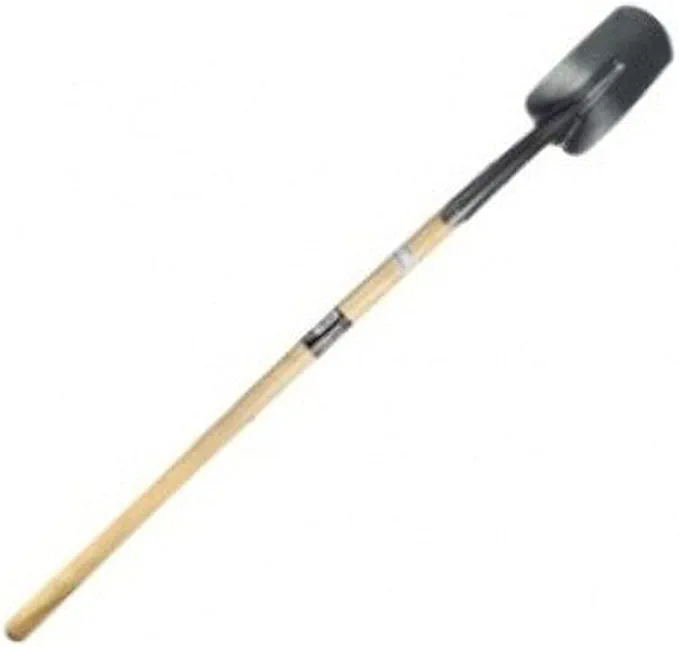
If you’re looking for clams at the beach, this clam shovel is the ideal digging tool to gather as much razor clam as you want. The blade is small, narrow, and angled, so it digs up clams better than the popular clam gun.
There are so many variations of the clam shovel available, with the semi or full-angled clam shovel giving you options on the depth of digging you want to do. You can use your body weight to force the Shovel into the ground and then lift it to reveal clams.
Final Thoughts
Shovels have varying uses; knowing them will make your work easier and protect the shovels from damage. However, with tens of different shovels available, finding the right Shovel for your digging needs may take time and effort. Luckily, you do not have to purchase all the Shovels as this guide has listed the most common with their uses.
